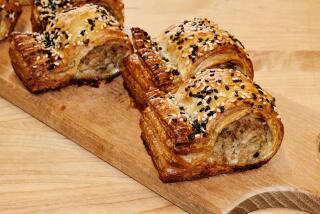Enjoying the Benefits of the Legume-Rich Palouse
- Share via
Some years ago, a close friend from eastern Washington mentioned that his area of the world is the dried pea and lentil capital of the United States. He even sent us a nifty cookbook produced by a pea and lentil trade group to prove his point.
The latest version of “The Pea & Lentil Cookbook: From Everyday to Gourmet” has beautiful color illustrations, lots of recipes and in-depth information about these nutritional superstars.
The rich agricultural area of Washington and Idaho, where more than 220 million pounds of lentils and 400 million pounds of dried peas are grown annually, is known as the Palouse (French for green lawn). Lentil pods are dried naturally in the late-summer sun and then processed without water or chemicals to get rid of seeds, dirt and other debris. However, when you read the instructions for cooking lentils, it always says that you should rinse them first, to remove the fine dust that has been left behind. Split peas, on the other hand, are steamed, beaten with paddles (which is why they split) and then polished to look clean and uniform.
Over the last 75 years, more than 70% of the lentils and dried peas grown in the Palouse region have been exported to other countries. With Americans’ growing awareness of these products’ nutritional value, however, more of this production will be staying on our shores.
Dried peas and lentils are extremely low in calories (about 110 per half-cup, cooked), high in fiber (especially the kind that reduces cholesterol and blood sugar), complex carbohydrates, protein, B vitamins and potassium. They also are versatile, taking on the flavor of whatever they are cooked with.
The following guidelines for cooking lentils and split peas come from “The Pea & Lentil Cookbook”:
* Rinse and drain split peas or lentils.
* Do not soak.
* For cooking, use twice the amount of liquid as split peas or lentils.
* Because it tends to toughen the seed coat and lengthen cooking time, add salt, if needed, at the end of the cooking time.
Stove-top instructions: In a saucepan, combine split peas or lentils and liquid. Cover; bring to a boil. Reduce heat and simmer. Cook 15 minutes for salads, 30 minutes for vegetables and main-dish recipes and 45 minutes for soups and purees. Check and stir frequently. Drain lentils and split peas for salad recipes. Pressure cooking is not advised.
Microwave instructions: Cooking time is about the same as the stove-top method. Putting split peas in a food processor for a minute will chop them just a little and expose more surfaces. This will shorten cooking time. Use twice the amount of liquid as split peas or lentils. Always cover, preferably with plastic wrap. Bring to a boil on high, reduce heat to medium for remainder of cooking time. No need to check or stir as often as when cooking on the stove top.
The recipes in the pea and lentil cookbook are analyzed for calories, protein, carbohydrate, fat, cholesterol, sodium and fiber, so it is easy to select those that will fit into your healthful, low-fat diet.
The new version of this cookbook is $24.95 and is available from the USA Dry Pea & Lentil Industry, 2780 W. Pullman Road, Moscow, ID 83843; (208) 882-3023. You can check out the Web site at https://www.pea-lentil.com.
*
Dr. Sheldon Margen is a professor of public health at UC Berkeley; Dale A. Ogar is managing editor of the UC Berkeley Wellness Letter. Send questions to Dale Ogar, School of Public Health, UC Berkeley, Berkeley, CA 94720-7360, or e-mail to daogar@uclink4.berkeley.edu. Eating Smart appears the second and fourth Mondays of the month.
More to Read
Eat your way across L.A.
Get our weekly Tasting Notes newsletter for reviews, news and more.
You may occasionally receive promotional content from the Los Angeles Times.







